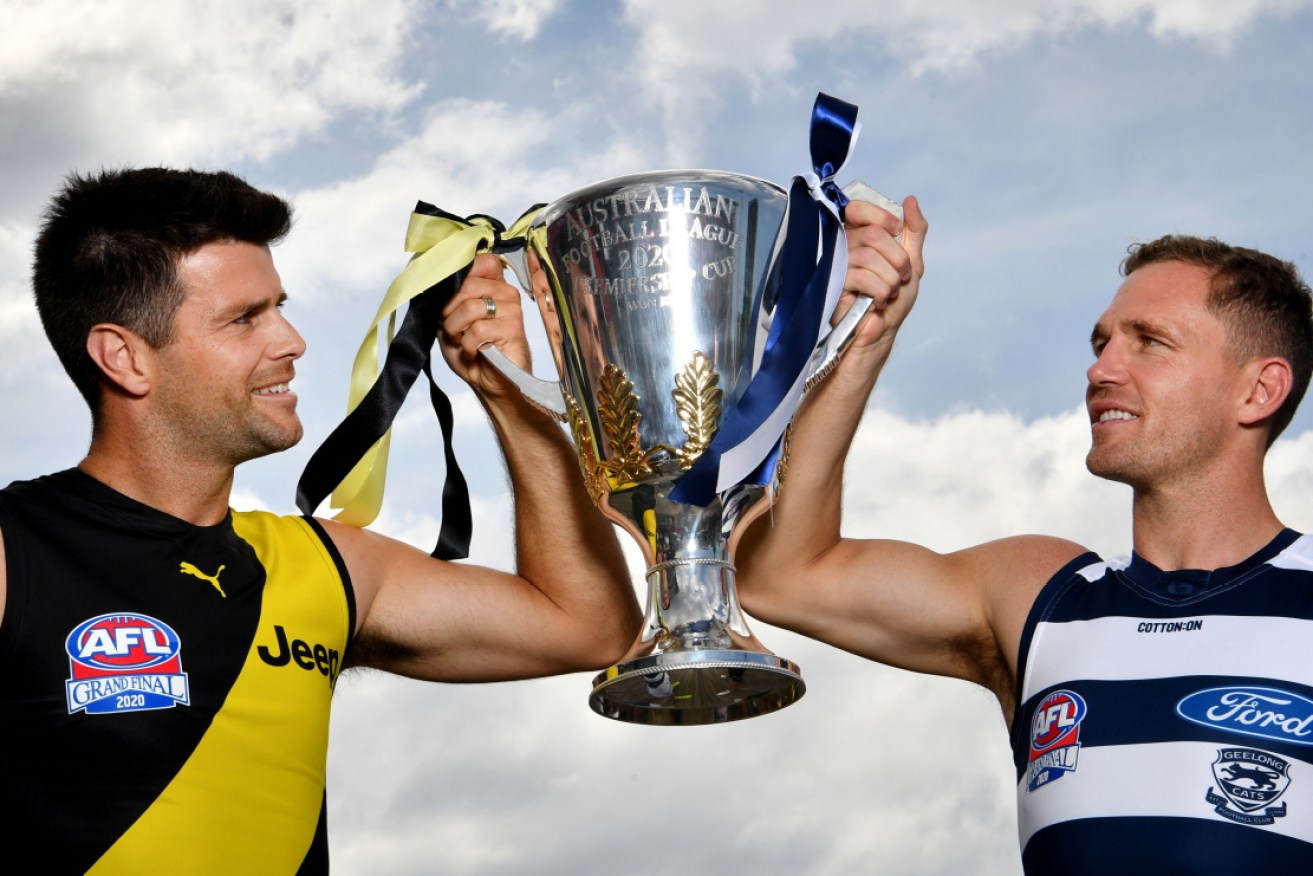AFL grand final: When Struggletown meets Sleepy Hollow, history is made


Richmond's Trent Cotchin and Geelong's Joel Selwood with the AFL premiership Cup on Friday. Photo: AAP
When AFL heart and soul club Fitzroy were packed off to Brisbane as part of the painful birth of a national competition in 1996, not even the most ambitious league official could have envisaged a Queensland night grand final between Richmond and Geelong would become the ultimate embodiment of that forward thinking.
As it turns out, the oh so Victorian clash of ‘Struggletown’ versus ‘Sleepy Hollow’ could well prove to be a defining moment in the evolution of Australian Rules football, with two of the AFL’s most storied clubs offering a cracking match-up and a panacea to pandemic.
In what shapes as an instant classic, Saturday night’s Gabba grand final promises storylines that have been years in the making – befitting the final act of this most unusual and challenging of football years.
Can Trent Cotchin become the first Tiger skipper to win three flags, or the rare talent of Dustin Martin snare another Norm Smith medal?

Tiger Dustin Martin in his final training session before the big game. Photo: AAP
Or will Patrick Dangerfield finally get a premiership medallion to match his Brownlow, and can Gary Ablett junior put a sizeable cherry on top of his career by becoming the first premiership player to leave his club and then return to win another?
In historical terms these clubs head into the 2020 decider with their toughest of times well behind them, but those stories offer a compelling reason for why this new era rivalry has attracted so much interest.
Richmond is the product of one of Melbourne’s toughest suburbs and offered Depression Era hope for its working class faithful with flags in the 1932 and ’34, enjoying more 1970s success before a premiership drought that stretched from 1980 to 2017.
Coach Damien Hardwick added another flag in 2019 for good measure, duly rewarding a forward thinking board who – very un-Tiger like – stood by their man when he had been unable to win a final in his first seven seasons.
Geelong also endured a premiership drought from 1963 to 2007, before adding another two in 2009 and 2011 – the latter in coach Chris Scott’s first season.
Scott has rebuilt on the run, ensuring his teams have missed the finals only once since then, all the while quietly turning the Cats into a destination club in a growing region that has long outgrown the ‘Sleepy Hollow’ reputation.
AFL historian and Geelong fan Col Hutchinson is one man who has seen it all at Kardinia Park, having famously not missed a Cats game since July 1963 until the coronavirus intervened.
Now, like the rest of us, Hutchinson will watch the Cats from home on Saturday night, aware that the farewell of Gary Ablett junior also marks a new epoch for a club that was re-invigorated by the arrival of Gary senior in the late 1980s.
“In 1989 when Geelong first made the finals with Gary Ablett in the group, the excitement level was extremely high at that stage,” Hutchinson told The New Daily, adding that even in narrowly losing to Hawthorn, it was clear that something had changed.
The quality of that [losing] grand final was so great and the excitement was so high during that match that with G Ablett kicking those nine goals that day it really just fired the supporters up.”
Geelong’s renaissance came at the same time as Richmond faced a financial crisis, forced to rattle tins in the famous Save Our Skins rally of 1990 – an event that staved off liquidation, but also meant another five years before a finals appearance.
The Tigers broke out of that malaise in 1995 under John Northey, only to run into a rampant Gary Ablett-inspired Geelong in the preliminary final.
Geelong lost to Carlton in the grand final and for Ablett senior there would be no fairytale ending with a premiership to match his 1989 Norm Smith medal.
Both cubs would experience lean times before suddenly bursting into the spotlight again in the past 10 years.
The Cats initially had more success, on field at least, but even when still battling to win finals, the Tigers had finally worked out how to monetise their huge supporter base.
Geelong rebuilt Kardinia Park and parlayed its geographic advantage of being on the surf coast in one of regional Victoria’s fastest growing growth corridors.
“The club is well run and, generally speaking, the player group is content,” notes Hutchinson. “And obviously when players talk among themselves the word spreads about the reputation of the club.”
As a statistician, Hutchison believes the return of Gary Ablett junior in 2018 after 110 games with the Gold Coast has all the makings of one of football’s great stories.

Gary Ablett junior is on the verge of making more football history. Photo: AAP
“It’s a wonderful story. If he achieves that premiership he will be the only player in history – if you look at the returnees, those who have returned to their original club after playing at another club in between – to have done that. So that would really top things off.”
Whatever the result, football fans in general should expect that this grand final will influence AFL thinking for years to come
The global pandemic this year gifted the AFL a trial run on all sorts of ‘reforms’ like shorter quarters, mid-week matches and conference-style fixturing. Expect the competition to move even further towards an American-style sports offering in years to come.
Having long flirted with the idea of a night grand final, AFL officials will also be closely looking at television ratings, fireworks and half-time entertainment – assessing their worth for when the crowds are back at a packed MCG.
It’s fitting then that two of the AFL’s oldest clubs should end this first 20 years of the new century with what will long remain as one of the most unique grand finals.
For the Tigers and Cats – no longer struggling or sleepy – the future starts now.
Richmond v Geelong – 2020 form line
Richmond: (finished third, 12 wins, 4 losses, 1 draw). Beaten by 15 points by Brisbane in a qualifying final, defeated St Kilda by 31 points in semi-final and outlasted Port Adelaide by six points the preliminary final.
Geelong: (finished fourth, 12 wins, 5 losses). Lost to Port Adelaide by 16 points in a qualifying final, hammered Collingwood by 68 in a semi and thrashed Brisbane by 40 points in a preliminary final.
Head-to-head
Overall: Richmond 90 wins Geelong 104 wins 3 draws
In finals: Richmond 9 wins Geelong 2 wins
Last time: Round 17, 2020: Richmond 7.15 (57) d Geelong 4.7 (31) at Metricon Stadium
Key players
Dustin Martin (Richmond). Two grand finals, two premierships, two Norm Smith medals. No player has won the Norm Smith three times since it was first awarded in 1979 with Gary Ayres, Andrew McLeod and Luke Hodge other multiple winners.
Patrick Dangerfield (Geelong). Rivals Martin for the label of best player in the competition but yet to play in a grand final at any level. A ferocious ball-hunter but also a dominant force when stationed in attack.
Tom Lynch (Richmond). The polarising key forward hasn’t played in a losing final since crossing from Gold Coast for the 2019 season, with a perfect five from five record. The main aerial threat for the Cats to counter.
Tom Hawkins (Geelong). The Coleman medallist is the linchpin of Geelong’s scoring: he’s kicked a league-high 48 goals himself and has also 23 goal assists – no player in the competition has more.
The stats
Richmond average the most inside 50s of any team – 46.9 a game compared with Geelong’s 43.3. The Cats rank second for clearances while the Tigers rank second-last.
-with AAP








